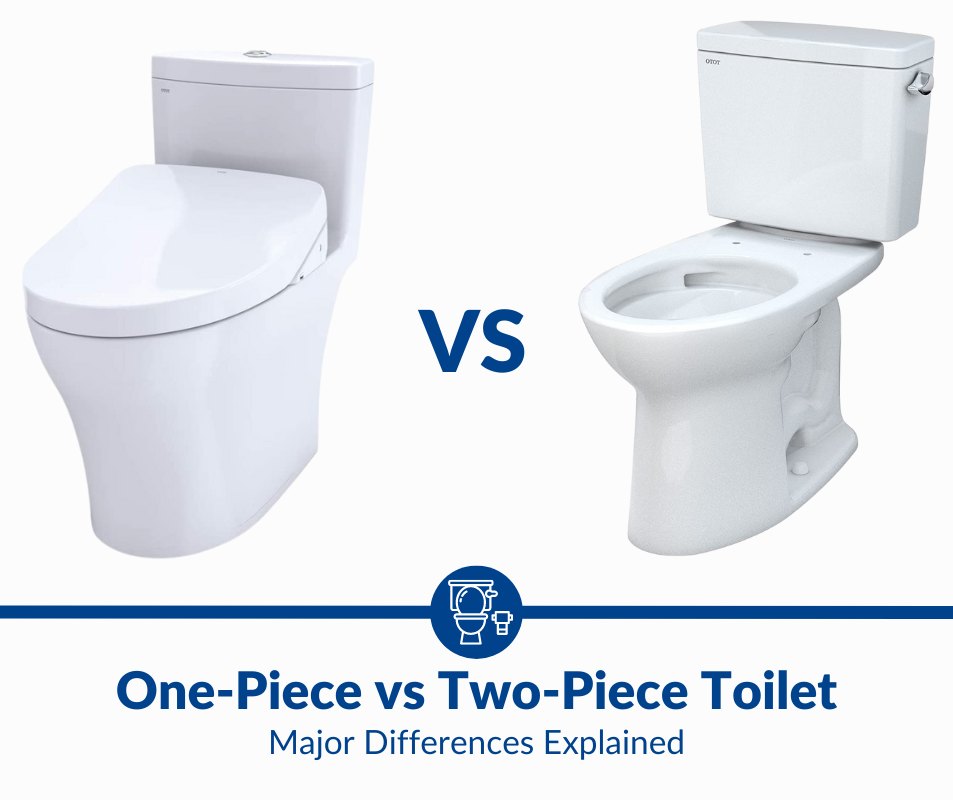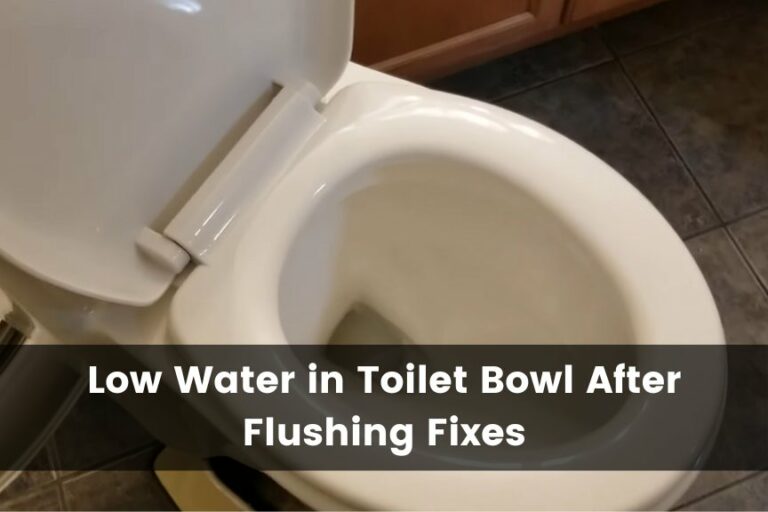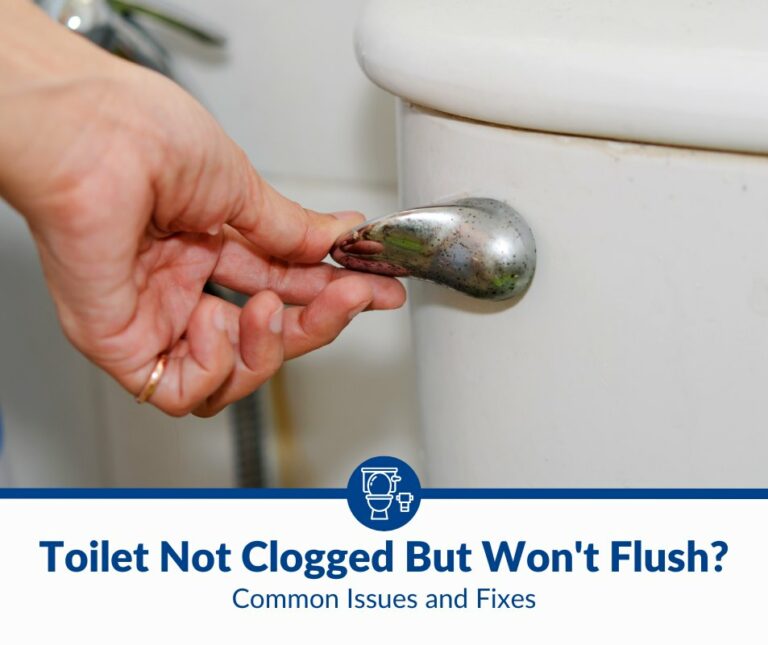One-Piece vs Two-Piece Toilet: Which Is Better?
When replacing or installing a toilet, one of the main decisions you’ll need to make is if you want a one-piece or two-piece toilet. This is extremely important, as the right toilet can change your bathroom’s function, appearance, ease of cleaning, and more.
One-piece toilets are easier to clean, sleeker, easier to assemble, more durable, and easier for children to use. Two-piece toilets, on the other hand, are easier to transport, less expensive, and easier for tall people to access.
This article will explore the pros and cons of one-piece toilets with connected tanks and bowls and two-piece toilets with separate tanks and bowls. I’ll also talk about other factors you should consider when choosing a toilet, direct you to other places where you can find out more about toilets, and give suggestions on where to buy new toilets/toilet parts and how to fix your faulty toilet.
One-Piece Toilets: Pros
One-piece toilets feature a connected toilet and tank in one body, so they don’t have any gap between the bowl and tank. They have many benefits, such as:
Ease of Cleaning
Because one-piece toilets don’t have any corners or joints, it’s easier to clean these toilets more thoroughly because there are no hard-to-reach places. There’s also less space for bacteria to grow, so one-piece toilets tend to stay cleaner for longer.
Sleek, Modern Design
One-piece toilets have a more sleek and modern design than two-piece toilets. Because there are no joints, they look more luxurious and contemporary and are usually available in either a round or elongated bowl shape. However, beyond those two options, you won’t find too many styles.
Ease of Access
Another benefit of one-piece toilets is that they’re usually lower to the ground, making them more accessible for people with disabilities, children, and the elderly. If you have someone in your household that struggles to get on a traditional toilet, getting a one-piece toilet may be the best option.
Durability
One-piece toilets are typically more durable than two-piece ones because the coupling holding the tank and the bowl together is a weak spot prone to cracking. Additionally, two-piece toilets have a rubber gasket between the two sections that can degrade, which makes the toilet less durable in the long run.
Installation and Assembly
Two-piece toilets require more assembly than one-piece toilets. Since one-piece toilets only have, well, one piece, they cut back on assembly time. However, one-piece toilets are heavier and more difficult to transport because you can’t move the parts separately.
One-Piece Toilets: Cons
Expensive
You’d think one-piece toilets are cheaper, but they’re actually more expensive than two-piece toilets. That’s because their installation can be a little trickier. One-piece toilets can be between $250 and $600, whereas the average two-piece toilet costs between $100 and $400.
Heavier
One-piece toilets are usually pretty heavy, averaging 100 pounds (45 kg). This weight makes transportation more difficult. It also makes one-piece toilets significantly heavier than two-piece ones, which average 50-60 pounds (23-27 kg) — just a little over half the one-piece versions.
Difficult To Ship
Because one-piece toilets are heavy, and you can’t separate the parts to make them easier to move, the shipping costs are significantly higher than a two-piece toilet. The additional shipping costs are another reason one-piece toilets are more expensive.
May Require Complete Replacement After Damage
One-piece toilets are extremely durable, but if they break, you’ll need to replace the entire thing instead of just one part; otherwise, the toilet won’t function. On the other hand, if a two-piece toilet breaks, you only need to replace the piece that got broken.
Two-Piece Toilets: Pros
Two-piece toilets are more common and traditional than one-piece toilets, so when you picture a toilet, you’re probably thinking of a two-piece model. Two-piece toilets have separate tans and bowls. Their benefits include:
Ease of Transport
Because you can separate the tank and the bowl, transporting a two-piece toilet is much easier than transporting a one-piece toilet. As a result, the shipping costs are usually much lower. You also don’t have to worry about having to awkwardly navigate nooks and crannies as you carry the two pieces of your toilet.
Ease of Installation
Not only does the separate tank and bowl make it easier to transport the toilet, but it also makes it easier to maneuver the pieces as they’re installed. If you’re paying someone to install your toilet, they’ll usually charge less for a two-piece toilet than a one-piece.
Wide Range of Styles
Since they have two pieces, you can mix and match different tanks and bowls if you prefer, and no two toilets will look the same. Because two-piece toilets have been around for longer and they’re the more traditional of the two options, you’ll have more choices in terms of style.
Wide Range of Prices
You can get a two-piece toilet for as low as $100, although more luxurious options (like the infamous golden “thrones” of the ultra-rich) can cost thousands of dollars. You can also pick from various features, like the type of flush (manual or automatic).
Comfort for Adults and Tall People
Two-piece toilets are more suitable for adults and taller people (those over six feet or 1.8 m) because they’re usually higher off the ground than one-piece toilets. Unless you have any children or elderly people in the house, a two-piece toilet may be more comfortable.
Ease of Repair
If your toilet does break, you’ll only have to replace the part that broke (the bowl or the tank) rather than the entire toilet. This makes fixing a broken toilet more affordable and easier than a one-piece one. Besides, you have the opportunity to upgrade at least one part of your toilet.
Two-Piece Toilets: Cons
More Likely To Break
The coupling connecting the toilet bowl to the tank is a weak spot in the toilet’s makeup and is prone to cracking, making these toilets less durable than one-piece toilets. On the other hand, since two-piece toilets are more common, it’s easier to find replacement parts, so this isn’t much of an issue.
Greater Chance of Leakage
The rubber gasket between the two toilet sections tends to degrade over time, which causes leakage. When leakage isn’t addressed on time, it can cause extensive damage to your bathroom, which is expensive and time-consuming to fix.
Not As Sleek
Two-piece toilets aren’t as aesthetically pleasing as one-piece toilets. All those additional joints and nooks can throw the whole look of these toilets off-balance. That said, they’re the more traditional of the two types of toilets, so only the pickiest people will likely take issue with you not having a one-piece toilet.
One-Piece vs Two-Piece Toilets: Comparison
Now that you have a better idea of the benefits and potential drawbacks of one-piece and two-piece toilets, let’s summarize the differences between the two via the table below.
| Characteristic | One-Piece Toilet | Two-Piece Toilet | Winner |
| Ease of Cleaning | One-piece toilets are easier to clean because all the areas you need to wipe/scrub are easily accessible. | You’ll have to exert more effort to clean two-piece toilets, as there are hard-to-reach areas like the nooks between the bowl and tank. | One-piece toilets are easier to clean and keep clean than two-piece toilets. |
| Design and Aesthetics | One-piece toilets are generally sleeker, more modern, and more pleasing to the eyes. | More style options are available for two-piece toilets since you can mix and match tanks and bowls. | One-piece toilets have a more updated look, whereas there are more opportunities for personalization with two-piece toilets. |
| Installation and Assembly | Installation is challenging because one-piece toilets are so heavy, though they don’t require as much assembly as two-piece toilets. | Two-piece toilets require assembly to connect the tank and the bowl. However, the ability to separate the tank from the bowl makes installation a bit easier. | Installing a one-piece toilet is more challenging because you can’t separate the tank from the bowl, but no additional assembly is required. |
| Transportation | One-piece toilets are difficult and more costly because they are so heavy. | Two-piece toilets are less heavy and bulky because you can separate the parts, so shipping is also less expensive. | Two-piece toilets are easier and cheaper to transport. |
| Price and Value | One-piece toilets are more expensive. | Two-piece toilets are available at various price points, so if you’re on a tighter budget, you’ll be able to find a quality two-piece toilet at a lower price. | Two-piece toilets are less expensive overall. Not only are they more common (so the greater supply pushes prices down), but the shipping costs are generally lower. |
| Durability | One-piece toilets are more durable than two-piece ones. | The area where the tank connects to the bowl is a weak spot. | One-piece toilets are more durable since they have fewer weak points (if any). |
| Ease of Repair | If a one-piece toilet breaks, you’ll have to replace the entire toilet. | If a two-piece toilet breaks, you’ll only need to replace the broken parts. | Two-piece toilets are easier and less expensive to repair. |
| Ease of Access | One-piece toilets are ideal for children and elderly people because they are lower to the ground and easier to access. | Two-piece toilets are easier for adults and taller people because they are higher off the ground, so people don’t have to squat as far down to reach the toilet bowl. | One-piece toilets are easier for shorter people, children, and elderly people, but two-piece toilets are easier for taller people. |
One-Piece vs Two-Piece Toilets: Factors To Consider
Aside from their general pros and cons, here are additional considerations you should account for when choosing between one-piece and two-piece toilets.
- Plumbing considerations. Performance- and plumbing-wise, one-piece and two-piece toilets are quite similar. In most cases, you can replace a two-piece toilet with a one-piece toilet without changing the plumbing.
- Personal preferences. For example, do you prefer your toilet closer to the ground or higher? Are the aesthetics of your toilet important, or do you simply want a nice place for you and your household members to “do your business”? How much time are you willing to spend cleaning your toilet?
- Hygiene. At some point, you’ve probably come across toilets that flush automatically as soon as you’re done with your business. They save you time, are more hygienic than traditional toilets, and are easier for those with mobility issues. However, they’re also more expensive.
- Bidet or no bidet. Most one-piece and two-piece toilets are bidet friendly. However, bidet attachments don’t fit well on deep French curve toilets, a popular one-piece toilet design.
Conclusion
One-piece toilets are easier to clean and assemble, sleeker, more durable, and easy for children and elderly people to access. On the other hand, two-piece toilets are easier to transport, more affordable, and easier for tall people to access. Whether one or the other is better boils down to your needs and preferences.
Additional Resources
Best Places To Buy Toilets
Whether you want to install a new toilet or replace your existing one, here are the best places to buy your new “throne.”
- Home Depot. The Home Depot offers one-piece and two-piece toilets, as well as all the toilet components you need, including toilet seats, bowls, tanks, and tank covers.
- Lowe’s. Lowe’s offers one-piece and two-piece toilets, as well as toilet bowls, tanks, and seats. You can also purchase urinals and bidets from Lowe’s.
- Online. If you don’t have the chance to go into a store in person, you can purchase a toilet online. You can go to Amazon.com, or visit the e-commerce websites for retailers like Home Depot, Lowe’s, Kohler, American Standard, and Wayfair.
Tips To Maintain Your Toilet
If you need help maintaining and troubleshooting your toilets, you can use these tips for both one-piece and two-piece varieties.
Clean Your Toilet Regularly
Cleaning your toilet is a good way to maintain your bathroom’s appearance and odor. It’s also a great opportunity to check your toilet and ensure everything works properly.
To clean your toilet:
- Pour the cleaner down the bowl. Let it sit for a few minutes or according to the instructions on your cleaner’s label.
- Meanwhile, clean the exterior of your toilet. Use a disinfectant. For stubborn stains, remove them using a scrub brush. Start from the top, so the stains will trickle down and save you cleaning time.
- Scrub the bowl with a toilet brush. Scrub until all the stains are gone. Once you’re done, flush the toilet at least twice to ensure all the soap is gone. Otherwise, the next person to use the toilet will feel awkward about doing their business in a soapy bowl.
Don’t Use Harsh Chemical Drain Cleaners
Some cog cleaners, like Drano, use harsh chemicals that damage the piping in toilets. Use gentle cleaners and other alternatives, like baking soda mixed with water. You can also purchase something like Mrs. Meyer’s Liquid Toilet Bowl Cleaner (available on Amazon.com), which contains plant-based ingredients and is gentler on your bowl (though you’ll have to use it more often).
Perform Regular Toilet Inspections
Every six months or so, check your toilet’s components to ensure your toilet is in good shape and everything is working properly. Watch out for leaks, cracks in the bowl, holes in the pipes, etc. As soon as you notice something is wrong, contact your local plumber immediately. Be prepared to pay for replacement parts if necessary.
Don’t Flush Anything but Human Waste Down the Toilet
One of the main causes of toilet issues is flushing things other than waste. You should avoid flushing “flushable” wipes and tampons because these objects can still clog your plumbing, even though they’re labeled as flushable. You should also avoid flushing Q-tips, paper towels, and other paper products.
Have a Separate Bin for Your Toilet Paper and Other Waste
You can purchase a trash can with a step lid to easily dispose of your toilet paper without worrying about the smell wafting within the bathroom. Don’t forget to put a plastic bag inside the bin for easier disposal. I recommend the Glad GLD-74506 Stainless Steel Step Trash Can (available on Amazon.com) for its odor control properties and stainless steel construction (meaning it’s less likely to rust from the moisture in your bathroom).
Reconsider Your Toilet Paper
If it’s not practical to have a separate waste bin for your used toilet paper (due to lack of space, for example), you can choose thinner toilet paper. Multi-ply and plush toilet paper tend to bulk up and cause clogging, whereas 1-ply paper dissolves easier. That said, I still recommend you avoid flushing toilet paper down your toilet as much as possible.
Call a Plumber When Necessary
Many issues, like clogging, can usually be solved with a plunger or drain snake. However, if there are more serious problems (e.g., your toilet flushing constantly on its own), you’ll want to leave the repair job to the professionals instead.







